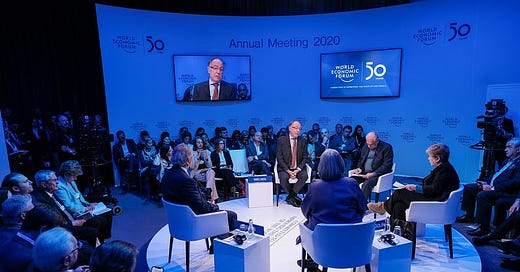Bogus inflation fears screw workers worldwide
Experts misunderstand money to justify lower wages
Welcome to a special edition of contention. This should take just about five minutes to read. Please take a moment to share with anybody you know that might like this analysis too!
As “whipsawing” Treasury yields hit a 14-month high this week, a new, relentless narrative only grew louder: inflation is on the horizon.
But these prophets of price increases aren’t focused on soaring housing costs or producer prices: they say that stimulus, infrastructure investments, and too much growth too fast could mean out of control costs.
These warnings are ill-informed at best and outright lies at worst. The truth: mainstream inflation rhetoric is mostly about keeping working people as poor as possible. Understanding why is a window into the actual ways the world economy works.
How Money Works
Money exists to circulate commodities. Inflation is the tendency over time for the same amount of money to buy fewer commodities. For a monetary system to maintain its credibility, the rise or fall in the value of commodities needs to mirror changes in the value of money itself.
The most common way societies have done this: pick one commodity and use it for money, usually a metal. If new technologies such as industrialization make it easier to produce all commodities, the money commodity should get less valuable -- i.e. there’s less effort invested in each piece of gold -- just like all of the other commodities.
Occasionally in those societies, the powers issuing money made it easier to pay off their debts by adding less valuable, “base” metals to coins. This “debasement” was a primary source of inflation, historically. Much of the rhetoric around inflation today implicitly assumes that increasing the money supply = debasement. But debasement was all about reducing inherent value in the money commodity, not just increasing supply.
Today’s global monetary system isn’t based on metals or any other commodity -- it’s based on the dollar without any direct commodity backing. This is historically very weird, but the dollar’s monopoly role in circulating critical commodities, the U.S. military’s global dominance, and dollar-denominated debt’s central role in global finance mutually reinforce one another to hold the system together.
Inflation and Austerity for Poor Countries
That means that most countries can debase their currencies because their dollar and other foreign reserves are their real money. Local currencies essentially act as tokens for domestic use, and the inflows and outflows of foreign reserves as well as the quantity of the national money supply determine inflation rates.
A proven strategy for turning poor countries into not-so-poor ones: loose monetary policies to subsidize domestic industry and consumption, growing the economy faster than an elevated inflation rate. Consumers will feel price pressures, but the long-term trajectory can benefit all.
The IMF and World Bank, however, condition their credit -- necessary to get access to private debt -- on countries adopting a deflationary stance. This keeps exports cheap for rich country consumers while preventing any accumulation that could boost wages. This means deflation in the countries where most of the world’s labor is done, underpinning a generation of historically low inflation.
Inflation and Austerity in Rich Countries
And yet U.S. experts keep warning us about inflation. Why? Because of the two primary sources of the country’s money supply: spending and lending.
Government deficits spend money into the economy, and the Federal Reserve buys up the bonds issued to finance the deficits. This has boosted the money supply by 40% in the last year alone.
Inflation hawks confuse supply increases with debasement, and warn that the government needs to cut back on the deficit spending. Since this rarely means raising taxes on the rich or cutting military budgets, the money comes out of social support programs and public services. Less support = more desperation = workers willing to settle for lower wages and worse conditions.
This raises the second leg of money supply and inflation fears: lending. Banks create money when they issue credit, and mainstream observers recommend higher interest rates to cool off “overheating” economies.
At the heart of this theory: the Phillips Curve, the idea that inflation and unemployment run in opposite directions. When unemployment is low, workers can ask for more money, raising business costs which owners pass on to consumers. Raising interest rates makes borrowing harder, reducing investment, forcing layoffs, raising unemployment and reducing inflation.
Former Fed Chairman Alan Greenspan raised rates aggressively in the late 1990s to “cool” this sort of overheating despite persistently low inflation. The economy has never returned to those growth rates. Now the Fed has adopted a looser policy, stoking investor fears that they won’t raise rates and kill jobs fast enough.
Soaring executive compensation and stock buybacks have not prompted demands for tightened financial conditions, just like deficit-swelling tax cuts never seemed to fuel inflation narratives. Altogether a generation of imported low wages, social spending stinginess, and monetary tightening at the first sign of income growth has meant a dramatic drop in working people’s share of U.S. wealth.
The Truth About Inflation
But inflation really is happening and the government is lying about it, right? Yes, but as we’ve reported before, the inflation isn’t caused by overheating or debasement, it’s caused by commodity pricing chaos in the wake of an ongoing, unprecedented reallocation of capital and labor worldwide.
Reducing social support for struggling people, demanding new austerities in the developing world, and actively suppressing the labor market won’t solve this problem, it will just make it more painful for billions of people.
The problem: a tiny number of people with all the wealth and power have the exact opposite interests. They see profit in this pain, and bad faith inflation warnings help them secure this advantage.
Disclaimer
Our only investment advice: Not Archegos.
Contact us with any feedback, questions, or stories we might have missed.




